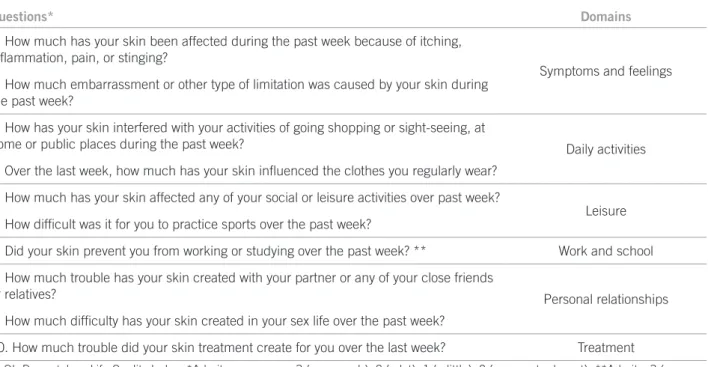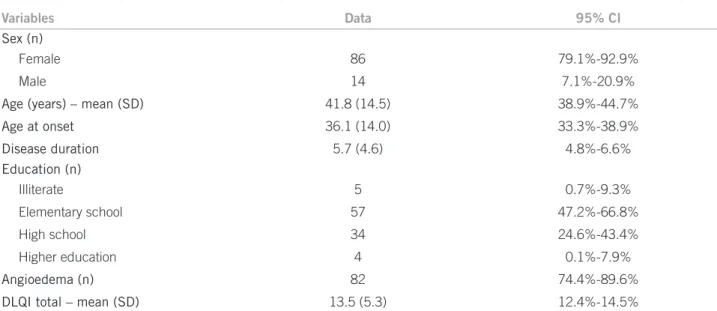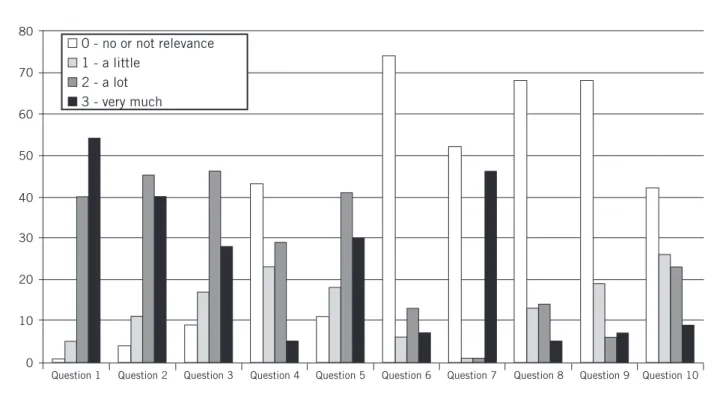SUMMARY
Objective: To evaluate the impact of chronic urticaria on quality of life of outpa-tients through the university questionnaire Dermatology Life Quality Index (DLQI).
Methods: Survey of the impact on quality of life caused by chronic urticaria, using the DLQI questionnaire validated for the Portuguese language. Patients were interviewed during visits to a specialized outpatient clinic between May 2009 and May 2010 at a Brazilian public service (Botucatu-SP). DLQI scores were analyzed according to the following subgroups: age, gender, education, disease duration, and presence of angio-edema. Results: We interviewed 100 patients with chronic urticaria. here was a female predominance (86%), mean age 41.8 years, mean disease duration of 6 years, and an-gioedema occurrence in 82% of patients. he mean DLQI score was 13.5, character-ized by serious impact on quality of life, higher than Hansen’s disease, psoriasis, atopic eczema, and basal cell carcinoma. he presence of angioedema was associated with higher scores: 14.5 x 9.9 (p < 0.01). Female patients reported greater impact on cloth-ing, while male patients reported treatment interference with work and study (p < 0.05).
Conclusion: Chronic urticaria seriously compromises the quality of life of patients eval-uated at a university service in Brazil, particularly of patients with angioedema.
Keywords: Angioedema, urticaria, quality of life, sickness impact proile; quality of life index.
Study conducted at the Department of Dermatology and Radiotherapy, Faculdade de Medicina de Botucatu, Universidade Estadual Paulista (UNESP), Botucatu, SP, Brazil
Submitted on: 04/30/2011
Approved on: 07/19/2011
Correspondence to:
Hélio Amante Miot Departamento de Dermatologia
e Radioterapia Faculdade de Medicina
de Botucatu Universidade Estadual Paulista (UNESP) Botucatu, SP, Brazil
CEP: 18618-000 Phone/Fax: 55 (14) 3882-4922 dermato@fmb.unesp.br
Conlicts of interest: None.
©2011 Elsevier Editora Ltda. All rights reserved.
Quality of life in chronic urticaria: a survey at a public university
outpatient clinic, Botucatu (Brazil)
MARIA REGINA CAVARIANI SILVARES1, MARIA RITA PARISE FORTES2, HÉLIO AMANTE MIOT1
INTRODUCTION
Chronic urticaria (CU) is a complex disease, which is rarely fatal, but signiicantly undermines the patients’ quality of life1. It is characterized by erythematous-edematous pap-ules and plaques, which are pruritic, evanescent, and recur-rent at irregular intervals. It lasts more than six weeks and is not clinically diferent from the acute form. CU may occur concomitantly with angioedema in about 40% of patients1-3. It is a common clinical condition, which is among the ten most common diagnoses in dermatological services1.
he disease prevalence is 0.1% in the general popula-tion; 0.27-2.1% in familial research; 1-5% in dermatologi-cal care; and 10% in visits to allergy clinics3-7. It is estimated that 12-25% of the population has had at least one episode of urticaria in their lifetime5,8, however, epidemiological studies of UC are scarce.
he impact of CU clinical symptoms on patients’ qual-ity of life (QoL) is oten underestimated, with few reports in literature. he Dermatology Life Quality Index (DLQI) was the irst construct for assessing the quality of life spe-ciically related to dermatology, developed by Finlay and Khan in 19949. It consists of 10 questions that estimate the inluence of disease with regard to symptoms, daily ac-tivities, leisure, work, school, personal relationships, and treatment. DLQI was translated and validated into Por-tuguese (Table 1) and has been already applied to several skin diseases10-16.
Perceptions about the impact of disease on patients’ lives are supported by cultural aspects, which justify its assessment in diferent populations. To date, there are no
studies of QoL and CU in Latin American populations. he authors’ aim was to assess the impact of chronic ur-ticaria on quality of life of patients treated at a university service in the city of Botucatu, Brazil.
METHODS
A survey of the impact on quality of life caused by CU was performed using the DLQI questionnaire validated for the Portuguese language (Table 1)16.
From May 2009 to May 2010, we selected consecutive patients with CU during their visits to the outpatient clinic of urticaria, Medical School, Unesp (Botucatu, SP). Pa-tients were well informed and agreed to participate in the study. he project was approved by the local Institutional Ethics Committee (protocol nº 3159/09).
Demographic, clinical, and health-related QoL data were investigated. DLQI total score was calculated by sum-ming the score of each of the 10 questions assessed and in-terpreted as no impairment of quality of life (0-1), mild im- pairment (2-5), moderate impairment (6-10), severe impairment (11-20), or very severe impairment (21-30)9.
Categorical data were represented by percentage fre-quencies; conidence intervals were estimated at 95% (95% CI) and compared by Person’s chi-square test for trend and residual analysis of the contingency table. Con-tinuous data were represented as means and standard deviations, and conidence intervals estimated at 95% (95% CI) and compared by Student’s t test. Normality was assessed by Shapiro-Wilk test and homoscedasticity by Levene17,18.
Questions* Domains
1. How much has your skin been affected during the past week because of itching, inlammation, pain, or stinging?
Symptoms and feelings 2. How much embarrassment or other type of limitation was caused by your skin during
the past week?
3. How has your skin interfered with your activities of going shopping or sight-seeing, at
home or public places during the past week? Daily activities
4. Over the last week, how much has your skin inluenced the clothes you regularly wear?
5. How much has your skin affected any of your social or leisure activities over past week?
Leisure 6. How dificult was it for you to practice sports over the past week?
7. Did your skin prevent you from working or studying over the past week? ** Work and school
8. How much trouble has your skin created with your partner or any of your close friends
or relatives? Personal relationships
9. How much dificulty has your skin created in your sex life over the past week?
10. How much trouble did your skin treatment create for you over the last week? Treatment
DLQI, Dermatology Life Quality Index; *Admits as answers: 3 (very much), 2 (a lot), 1 (a little), 0 (no or not relevant); **Admits: 3 (very much) or 0 (no or not relevant). If not, ask: Has your skin been a problem for you at work or school? If yes: 2 (very much) or 0 (no or not relevant).
Subsequently, analysis of total scores and independent variables (gender, age, education, disease duration and presence of angioedema), according to subgroups, was performed. Data were adjusted by analysis of covariance17.
he result of question scores was assessed by dendro-gram resulting from hierarchical cluster analysis, and the questionnaire internal consistency was estimated by Cron-bach’s alpha17.
Sample size was based on pre-test with 80 patients, as-suming alpha and beta errors of 5% and 20%, respectively, and results were tabulated in MSExcel 2003 and analyzed by SPSS 17.0 sotware19. Two-sided p-value of < 0.05 was considered statically signiicant17.
RESULTS
One hundred patients with UC were interviewed. he main demographic and quality of life data are shown in Table 2.
It is noteworthy that there was a female predominance (6:1), involvement of working-age adults, mean total DLQI score classiied as “severe impairment of quality of life”, and high frequency of angioedema.
here was no exclusion of patients, and all agreed to participate.
Cronbach’s alpha resulted in 0.73, ensuring internal consistency of the questionnaire.
Scores of the diferent domains assessed by the DLQI questionnaire are shown in Figure 1. Analysis of scores (hierarchical clustering) and residual analysis of the con-tingency table showed more severe involvement of CU in areas relating to symptoms and feelings (questions 1 and 2), daily activities (question 3) and leisure (question 5).
Presence of angioedema was the only variable that was signiicantly associated with worst scores on DLQI, even when adjusted for gender, age, disease duration and edu-cation. he mean score (± SD) of DLQI for patients with
angioedema was 14.3 (± 5.3) versus 9.9 (± 3.8) for patients without angioedema (p < 0.01).
Regarding gender, there was a greater impact of CU on quality of life of women in question 4 (clothing), while in question 7 (work/study) and question 10 (treatment), the impact was greater for men (p < 0.05).
Patients with more education (secondary and higher education) reported higher impact of CU on quality of life on questions 2 (embarrassment) and 6 (sports), when compared with those without education or with primary education (p < 0.05). Older ages were signiicantly associ-ated with lower scores only on question 4 (clothing).
Finally, longer duration of illness was associated with lower scores on questions 1 (symptoms) and 4 (clothing), but with higher scores on questions 2 (embarrassment) and 7 (work/study) (p < 0.05).
DISCUSSION
In this study of Brazilian adult patients, CU has caused severe impairment of quality of life, particularly among patients with CU and angioedema (DLQI 14.3 points) compared with patients with CU alone (DLQI 9.9 points).
Angioedema is oten associated with long-lasting and resistant cases of CU, as occurs in patients with physical urticaria; positive autologous serum test; and more exten-sive cases7,20,21.
In addition, patients with angioedema sufer major limitations related to diferent daily activities, especially due to the symptoms that cause embarrassment in public places, sports, work/study, and leisure.
he authors believe that the high frequency of angio-edema in this series occurred because the institution is a referral service, which receives cases that are more severe, long-lasting, and less responsive to treatment with conven-tional antihistamines22.
Variables Data 95% CI
Sex (n)
Female 86 79.1%-92.9%
Male 14 7.1%-20.9%
Age (years) – mean (SD) 41.8 (14.5) 38.9%-44.7%
Age at onset 36.1 (14.0) 33.3%-38.9%
Disease duration 5.7 (4.6) 4.8%-6.6%
Education (n)
Illiterate 5 0.7%-9.3%
Elementary school 57 47.2%-66.8%
High school 34 24.6%-43.4%
Higher education 4 0.1%-7.9%
Angioedema (n) 82 74.4%-89.6%
DLQI total – mean (SD) 13.5 (5.3) 12.4%-14.5%
DLQI, Dermatology Life Quality Index; SD, standard deviation; 95% CI, 95% conidence interval.
National studies of other dermatoses, also chronic, such as Hansen’s disease and psoriasis, atopic dermati-tis, and vitiligo, among others (Table 3), also observed a substantial impact on QoL of their patients, indicated by the high scores on DLQI7,16,23-26. However, in this work, we found mean scores even higher for patients with CU.
In fact, the CU has an impact on QoL, and its indi-ces resemble those of patients ater myocardial infarc-tion7,20,21,27. Although chronic, CU has features of acute and unusual onset. Such unpredictability can limit everyday activities and generate sudden limitations.
Another factor that may contribute to the perception of QoL impairment refers to the high coexistence of psy-chiatric disorder (35-50%), especially anxiety, depression, somatoform disorders, and sleep disorders, as identiied in other studies involving series of patients with CU28-30.
We also found strong association of female with CU; this inding is consistent with other previous studies6,7,22. In fact, women are more afected not only by CU, but by other autoimmune diseases.
Similarly, the perceived impact on the QoL of women was diferent from men in domains related to clothing, work/study, and treatment. A possible explanation for this is the characteristic of female vanity that may have inlu-enced the higher scores for daily activities. Jobs requiring concentration, such as drivers and machine operators, are predominantly male, which may explain the higher scores of men in these domains, mainly inluenced by the side efects of treatments.
he impact on clothing was also signiicantly higher among young people, probably due to the more meaning-ful representation of clothing in their everyday lives.
he educational level was associated with greater im-pact on questions relating to symptoms and feelings, as well as leisure, suggesting that patients with more educa-tion are more socially exposed or overconcerned with such exposure.
Patients with long-lasting disease complain less about the impact related to symptoms and clothing, however, they reported greater social embarrassment and impact on work.
Disease Mean DLQI
Chronic urticaria 13.5
Hansen’s disease 11.0
Psoriasis 10.3
Basal cell carcinoma 8.5 Atopic dermatitis 7.9
Acne 7.4
Contact dermatitis 6.5
Alopecia areata 4.6
Vitiligo 4.0
DLQI, Dermatology Life Quality Index.
Table 3 – DLQI mean scores for dermatological conditions in Brazilian populations16,26
80
70
60
50
40
30
20
10
0
Question 1 Question 2 Question 3 Question 4 Question 5 Question 6 Question 7 Question 8 Question 9 Question 10
0 - no or not relevance 1 - a little
2 - a lot 3 - very much
Resignation in the face of chronic disease can result from strong doctor-patient relationship and realistic un-derstanding of disease severity, minimizing their fears. On the other hand, the chronicity of disease can lead to events of absenteeism, professional rehabilitation, and frustra-tions in social relafrustra-tions.
Possible limitations of this study may be the lack of comparative analysis with other dermatoses and the ho-mogeneity of patients coming from a tertiary public ser-vice, restricting data generalization, mainly related to socioeconomic characteristics and severity of clinical conditions. However, qualitative studies are, per se, popu-lation perceptions linked to cultural aspects that should not be compared between groups, but that characterize a population.
CONCLUSION
Chronic urticaria seriously compromises the quality of life of patients evaluated at a university service in Brazil, par-ticularly of patients with angioedema.
REFERENCES
1. Zuberbier T, Oanta A, Bogacka E, Medina I, Wesel F, Uhl P et al. Comparison of the eicacy and safety of bilastine 20 mg vs levoceti-rizine 5 mg for the treatment of chronic idiopathic urticaria: a multi-centre, double-blind, randomized, placebo-controlled study. Allergy 2010;65:516-28.
2. Kaplan AP. Chronic urticaria: pathogenesis and treatment. J Allergy Clin Immunol 2004;114:465-74; quiz 75.
3. Kozel MM, Sabroe RA. Chronic urticaria: aetiology, management and current and future treatment options. Drugs 2004;64:2515-36. 4. Schocket AL. Chronic urticaria: pathophysiology and etiology, or the
what and why. Allergy Asthma Proc 2006;27:90-5.
5. Greaves M. Chronic urticaria. J Allergy Clin Immunol 2000;105:664-72. 6. Champion RH, Roberts SO, Carpenter RG, Roger JH. Urticar-ia and angio-oedema. A review of 554 patients. Br J Dermatol 1969;81:588-97.
7. Weller K, Altrichter S, Ardelean E, Krause K, Magerl M, Metz M et al. [Chronic urticaria. Prevalence, course, prognostic factors and im-pact]. Hautarzt 2010;61:750-7.
8. Greaves MW. Chronic urticaria. N Engl J Med 1995;332:1767-72. 9. Finlay AY, Khan GK. Dermatology Life Quality Index (DLQI)--a
simple practical measure for routine clinical use. Clin Exp Dermatol 1994;19:210-6.
10. Lennox RD, Leahy MJ. Validation of the Dermatology Life Quality Index as an outcome measure for urticaria-related quality of life. Ann Allergy Asthma Immunol 2004;93:142-6.
11. Aghaei S, Sodaii M, Jafari P, Mazharinia N, Finlay AY. DLQI scores in vitiligo: reliability and validity of the Persian version. BMC Der-matol 2004;4:8.
12. Badia X, Mascaro JM, Lozano R. Measuring health-related quality of life in patients with mild to moderate eczema and psoriasis: clinical validity, reliability and sensitivity to change of the DLQI. he Cavide Research Group. Br J Dermatol 1999;141:698-702.
13. Mazzotti E, Barbaranelli C, Picardi A, Abeni D, Pasquini P. Psy-chometric properties of the Dermatology Life Quality Index (DLQI) in 900 Italian patients with psoriasis. Acta Derm Venereol 2005;85:409-13.
14. Balci DD, Inandi T, Dogramaci CA, Celik E. DLQI scores in patients with keloids and hypertrophic scars: a prospective case control study. J Dtsch Dermatol Ges 2009;7:688-92.
15. Nijsten T, Meads DM, McKenna SP. Dimensionality of the dermatol-ogy life quality index (DLQI): a commentary. Acta Derm Venereol 2006;86:284-5.
16. Adaptação e validação DLQI (Dermatology Life Quality Index) para uma amostra brasileira: avaliando qualidade de vida em dermatolo-gia. PsiqWeb, 2004. (cited 2011 Mar 15]. Available from: http://www. virtualpsy.org/psicossomatica/dermato3.html.
17. Norman GR, Streiner DL. Biostatistics. he bare essentials. 3rd ed. Shelton, Connecticut: Peoples Medical Publishing House; 2008. 18. Henderson AR. Testing experimental data for univariate normality.
Clin Chim Acta 2006;366:112-29.
19. SPSS 17.0 for Windows. Statistical Package for Social Science (SPSS). Chicago: SPSS Incorporation; 2008.
20. O’Donnell BF, Lawlor F, Simpson J, Morgan M, Greaves MW. he impact of chronic urticaria on the quality of life. Br J Dermatol 1997;136:197-201.
21. Poon E, Seed PT, Greaves MW, Kobza-Black A. he extent and na-ture of disability in diferent urticarial conditions. Br J Dermatol 1999;140:667-71.
22. Silvares MR, Coelho KI, Dalben I, Lastoria JC, Abbade LP. Sociode-mographic and clinical characteristics, causal factors and evolution of a group of patients with chronic urticaria-angioedema. São Paulo Med J 2007;125:281-5.
23. Finlay AY. Current severe psoriasis and the rule of tens. Br J Derma-tol 2005;152:861-7.
24. Finlay AY. Quality of life in atopic dermatitis. J Am Acad Dermatol 2001;45:S64-6.
25. Maurer M, Ortonne JP, Zuberbier T. Chronic urticaria: a patient sur-vey on quality-of-life, treatment usage and doctor-patient relation. Allergy 2009;64:581-8.
26. Martins BDL, Torres FN, Oliveira MLWDR. Impact on the quality of life of patients with Hansens disease: correlation between Der-matology Life Quality Index and disease status. An Bras Dermatol 2008;83:39-43.
27. Abdul Ghafar S, Finlay AY. Moral and cost dilemma of a psoriasis patient. Br J Dermatol 2007;156:186-7.
28. Staubach P, Eckhardt-Henn A, Dechene M, Vonend A, Metz M, Magerl M et al. Quality of life in patients with chronic urticaria is diferentially impaired and determined by psychiatric comorbidity. Br J Dermatol 2006;154:294-8.
29. Picardi A, Abeni D, Melchi CF, Puddu P, Pasquini P. Psychiatric mor-bidity in dermatological outpatients: an issue to be recognized. Br J Dermatol 2000;143:983-91.


